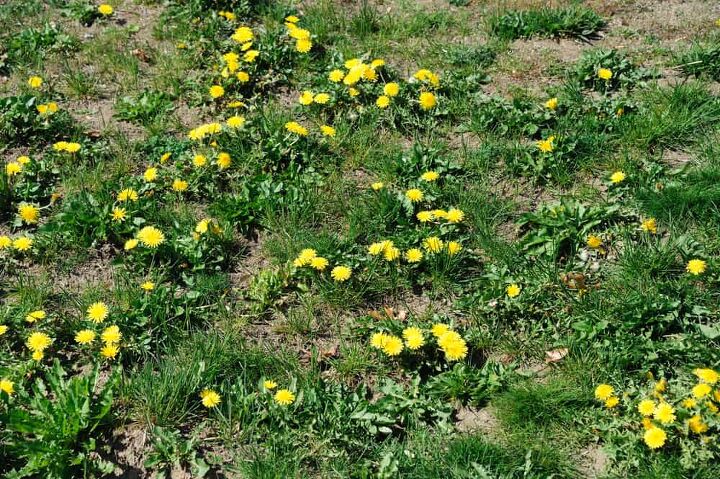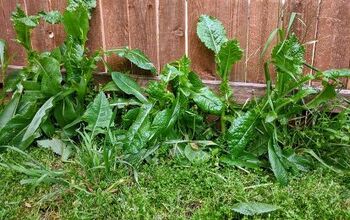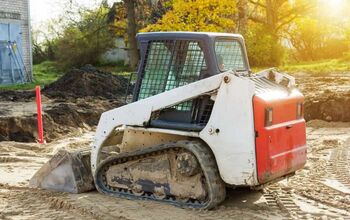How To Clear A Yard Full Of Weeds (Step-by-Step Guide)

A weed can be any plant that’s growing where you don’t want it to, like your yard or landscape. One person’s beautiful, natural yard is another person’s eyesore. If your yard is overrun by unwelcome weeds, there are several options to eradicate them.
To clear a yard full of weeds use chemical weed treatments like Weed and Feed or Weed B-Gon. To clear weeds naturally, you can kill them with boiling water and salt or smother them with newspaper. Vinegar with 20% acetic acid kills weeds on contact, but can also kill surrounding plant life, so protect nearby greenery and soil.
In this article, we’ll give you a broad overview of how to clear a yard full of weeds. Next, we’ll guide you through the most common lawn weeds and tell you how to tackle each specific plant.
Do You Need Lawn and Tree Maintenace Pros?
Get free, zero-commitment quotes from pro contractors near you.

Why Is My Yard Full Of Weeds?
Like any other plant, weeds thrive in certain conditions. While these conditions vary between types of weeds, there are a few main factors that contribute to weed growth:
Sparse, thinning grass. Weeds flourish when they don’t have a lot of competition for space. Growing thick, dense grass is a great way to keep weeds out.
Lack of water: Weeds also compete with your grass for moisture. They tend to absorb any available water when you’re not watering your lawn enough, leaving your grass thirsty.
Compacted soil: Your soil can get compacted when it’s heavily used, or without proper soil makeup. When this happens, your grass lacks access to appropriate nutrition, water, and air. Weeds grow well in compacted soil.
How To Clear A Yard Full Of Weeds
There isn’t a single, foolproof method to get rid of every weed. The most appropriate method for your yard depends on the type of weed you’re aiming to eliminate. It also depends on your preferred treatment.
Here’s an overview of the steps you’ll take to get rid of the weeds:
Step 1: Identify the Weeds
As we mentioned before, each weed is unique and will require different treatment methods. That being said, weeds fall into three main categories:
- Annual: These weeds produce seeds during just one season per year.
- Biennial: These produce seeds during two seasons, back-to-back.
- Perennial: This kind of weed is the most challenging to get rid of, as they produce seeds throughout multiple seasons.
Step 2: Choose Your Treatment To Clear A Yard Full Of Weeds
Herbicides:
There are two main types of herbicides – the chemical products that kill weeds. Pre-emergent herbicides prevent unwanted weeds from sprouting in your yard. Post-emergent weeds target established weeds.
There are several kinds of post-emergent herbicides that contain different chemicals to target the types of weeds in your yard. Read the labels to determine which product is appropriate for your lawn.
Herbicides often claim to only target the undesired weeds while leaving your grass intact. However, be prepared for the possibility that herbicide can kill any kind of plant life, including your grass. But if your grass is completely overrun, you may want to start fresh anyway.
Natural:
There are several non-toxic, chemical-free options for killing weeds. You can purchase a natural weed-killing product, or try one of these remedies:
Boiling water: Boiling a pot of water with salt in it can kill weeds immediately.
Newspaper: This helps to smother weeds and deprive them of sunlight. It can also feed the soil when the newspaper starts to decompose.
Vinegar: For the non-grassy weeds, horticultural vinegar with at least 20% acetic acid kills on contact. However, it also kills just about anything green and can lower the pH level in your soil.
Step 3: Apply Your Treatment
Make sure you follow the manufacturer’s instructions exactly. Weed killers often need to be applied under certain conditions, so check your local forecast.
Step 4: Stand Back and Wait (Patiently)
Wait for the weed killer to do its job. Depending on the product you used, you might have to wait to plant grass seed. Some weed killers and preventatives could prevent grass seeds from growing.
Step 5: Till Your Soil
Once your weeds are dead, use a garden fork to remove the dead plants and till the soil.
Step 6: Aerate
When your soil is compacted, it prevents air, water, and other nutrients from reaching the roots. Aeration breaks up the soil to make a pathway for those essential elements to reach your grass roots. Aerating can be done with spike aerators strapped to your shoes, powered equipment, or a professional lawn service.
Step 7: Test and Amend the Soil
For best results, test the pH level of your soil. You’ll want your soil pH to be between 6.0-7.5. If necessary, use a soil amendment to alter the condition of your soil.
Step 8: Fertilize and Plant
Add either a seeding soil or starter grass fertilizer to the top of your soil with a spreader. Then use the spreader to spread your grass seed evenly throughout the lawn.
Step 9: Water
With new seeds, use a sprinkler with a mist setting to water the grass gently. This will ensure your new seeds don’t get washed away. Deep and infrequent watering is best to allow your grass to grow deep roots that leave little room for weeds.
Depending on weather conditions in your area, you should water about twice per week, in the mornings. Aim to give your lawn 1-1.5 inches of water per week, depending on the type of seed you’re using.
Most Common Weeds and How to Get Rid of Them
Once you identify the types of weeds in your lawn, you’ll need to learn more about how to target them. Here’s a quick guide to some of the most common lawn weeds, and how to clear them from your yard.
| Name | Description | Herbicide Removal | Organic Removal |
Common Ragweed | An annual plant that grows upright, with fuzzy, feathery leaves. The flowers are long and yellow. It’s also a common allergen. | Use a broadleaf weed killer, preferably in mid-spring to early summer. | Use vinegar with 20% acetic acid to spray the weeds. This will kill them within a few days. |
Dandelion | A broadleaf perennial with yellow flowers. | Use a broadleaf herbicide, such as Roundup for lawns. | For smaller patches, dig up the dandelions. Boiling water, rubbing alcohol and vinegar are also good methods for killing them. You can then remove them more easily. |
Crabgrass | A grass-like annual plant that loves hot, dry conditions. They grow in the thin, patchy spots of your lawn. | Broadleaf herbicide like Roundup for lawn works well on crabgrass. | Smother it with newspaper to block it from sunlight. Wait 4-6 weeks and then remove it. Gardening vinegar with at least 5% acidity works well, too. |
White Clover | A perennial weed that grows low to the ground. Typically found in lawns. | A broadleaf herbicide will kill white clover. | Use plastic sheeting or newspaper to smother clover and kill it within a few weeks. Vinegar mixed with dish soap is also effective. |
Nutsedge | A perennial weed that looks like grass, but grows faster and gets taller. Cannot be prevented with a pre-emergent. | Pick a post-emergent herbicide containing halosulfuron or slufentrazone to kill nutsedge. As a bonus – these types of herbicides often spare your grass seeds. | Daily sprays with 20% acidic vinegar will eventually kill nutsedge. You can also wet the lawn where the weed is, and spread sugar through a sifter to kill it. |
Creeping Charlie | A broadleaf perennial that is difficult to control. It grows low to the ground in the moist and shade and can kill any plant surrounding it. | Use a broadleaf herbicide that contains triclopyr or dicamba. These will not hurt your grass. | Smother large areas with newspaper or cardboard for a week. |
Preventing Weeds From Growing
Once you’ve cleared your weeds, your best defense from here on out is proper lawn maintenance. Here are some tips to take care of your yard and prevent weeds:
- Perform frequent checks for weeds. When you see any growth, it’s important to remove them while they’re young. Pull the weeds up by hand, or cut them below the soil line and make sure you’ve removed the roots. Then, discard the dead weeds.
- Make sure your tools are clean after digging up weeds. Seeds can hang onto your garden tools undetected and be spread to other areas.
- Regular, higher mowing is one of the best ways to prevent weeds. When you mow your lawn too low, it weakens your grass and prevents them from producing enough nutrients. You should always mow at the highest level – about 3 inches.
- Make sure you’re using the correct amount of fertilizer. Using too much or too little can encourage weed growth.
Do You Need Lawn and Tree Maintenace Pros?
Get free, zero-commitment quotes from pro contractors near you.

Related Questions
Can I leave the dead weeds in my yard after treating them?
One or two dead weeds left in the yard won’t hurt anything. But a yard full of dead weeds could impede your new grass from growing properly. As tedious as it might be, you will have to go through the yard and rake and remove the dead weeds.
How can I prevent weeds in my garden?
First, make sure you only dig when you need to. There are always weed seeds in your garden. But they only grow when they’re moved into the first couple inches of soil. Another way to prevent weeds is by using plenty of mulch. Mulch keeps the soil moist and prevents weeds from getting any light. Also, make a regular weeding schedule to tackle any that are cropping up.

Kathryn is a craft aficionado who loves writing about DIY home improvement projects. When she's not writing, she loves reading, listening to musicals, and playing with her kids.
More by Kathryn Flegal














![10 Best Cordless Leaf Blowers – [2022 Reviews & Ultimate Guide]](https://cdn-fastly.upgradedhome.com/media/2023/07/31/9070789/10-best-cordless-leaf-blowers-2022-reviews-ultimate-guide.jpg?size=350x220)












